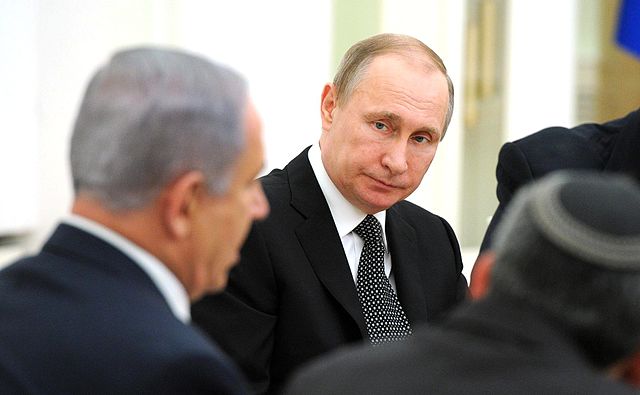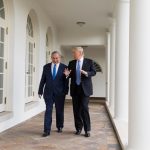by Gareth Smyth
Just five days before Israel’s general election, Likud party leader and Israeli Prime Minister Benjamin Netanyahu flew to Sochi, Russia, to meet with Russian President Vladimir Putin and Defense Minister Sergei Shoigu. Back home in Tel Aviv, a huge poster of Netanyahu and Putin was fluttering from the Likud headquarters, presumably to impress the 770,000 Russian speakers making up 12% of Israel’s voters.
The same day—Thursday 12 September—Saudi energy minister Prince Abdulaziz bin Salman and his Russian counterpart, Alexander Novak, were in Abu Dhabi coordinating the plan of ‘OPEC+’ to cut oil production by 1.2 million barrels per day until March 2020.
Back in late August, with tensions escalating between Hezbollah and Israel after two Israel drones crashed in Beirut’s southern suburbs, Lebanonese Prime Minister Saad al-Hariri appealed for assistance not to Washington or the United Nations but to Moscow. One Beirut newspaper later claimed Russia had helped limit the subsequent fire-fight on the Lebanon-Israel border to theatrics avoiding any deaths or injuries. “The Hezbollah reply and the IDF [Israeli defense forces] response have been measured, almost to the extent of being pro-forma,” a British security expert told me. “Hezbollah used short-range guided missiles, while the IDF fired into open fields.”
When the Soviet Union imploded in 1989-91, many Americans saw a new world order dominated by the U.S. as the only superpower. Throughout the 1990s, Russia’s focus shrank as new republics broke away in Belarus, Ukraine, and the Baltic, while oligarch business moguls became rich stripping state-owned assets. The first post-Soviet president, Boris Yeltsin, was increasingly directionless and made little effort to reassert Russia’s international role.
This changed gradually after 2000, when Putin became president. By 2006, Yevgeny Primakov—former Russian intelligence chief and foreign minister—wrote that Russia was “very much focused in taking a more active part in resolving Middle East issues.” But there were significant challenges. The U.S.-led invasion of Iraq in 2003 shocked Putin in flouting international law and simply ignoring the UN security council—where Russia held a veto—just as it had done over the NATO attack on Kosovo in 1999. “Watching his frequent appearances on Russian television at the time, you could see that Putin was both peeved and very angry,” wrote his British biographer Peter Truscott in Putin’s Progress, published in 2004.
The onset of the ‘Arab Spring’ in 2011 further unsettled Russia, and yet Moscow coped far better than the U.S. In his recent book Winners and Losers in the Arab Spring: Profiles in Chaos, Yossi Alpher, former Israeli intelligence officer, offers a brilliant analysis of Russia’s re-orientation:
That Russia exploited the chaos in Syria so successfully during the years 2015-19 must be understood as a grand strategic achievement for President Vladimir Putin. He skillfully assembled Russian ‘Arabists’, diplomats and generals in the Kremlin in the summer of 2015 and analyzed with them the situation in global terms. Based on that analysis and more than three decades of his own intelligence and political experience, Putin made a series of far-reaching rapid-fire decisions regarding the Middle East. He effectively deployed a wide variety of strategic tools to achieve his aims in Syria and broader region, yet without risking heavy military losses.
Alpher recalls his own discussion in 2017 during a Middle East conference with “Professor Vitaly Naumkin, perhaps Russia’s foremost authority on the Arab world, in the lobby of a luxurious Moscow hotel that offered caviar for breakfast and boasted heated toilet seats.” Naumkin told Alpher about a conversation he’d had in 2011 with Yevgeny Primakov, who had died in 2015, when Primakov had “simply shrugged his shoulders in a gesture that said ‘I don’t have a clue why this happened.’”
Russian analysts and officials had not just the humility but the where-with-all missing in their U.S. counterparts. This enabled its leaders to set objectives, define interests, and act to achieve them, decisively and sometimes brutally.
American predictions that Syria would be Moscow’s Vietnam proved misplaced, while Russian politicians and public came to regard its military intervention as a success. Moscow has both combated Islamic extremism—seen as a domestic threat after the 2002 Moscow Dubrovka Theater siege and the 2004 Beslan school massacre—and acquired assets in the Tartus naval base and the Hmeimim air base.
“Syria and the Middle East have become important arenas for Russia to articulate military strength and gain weight on the international stage,” says Zaur Gasimov, senior research fellow at the University of Bonn’s Russian Studies Department and a Baku-born German national. “Russia’s come-back to the Middle East…has forced traditionally American-oriented countries like Israel to look for understanding with Moscow.”
The impetus for Israeli-Russian intelligence coordination in Syria was that both were flying jets in Syrian airspace and wanted to avoid an incident like the 2018 downing of an Israeli F-16 by a Russian-supplied Syrian surface-to-air missile. This is despite Russia’s intervention being in support of president Bashar al-Assad, whom Israel regards as dangerously close both to Hezbollah and Iran.
Moscow’s relationship with Tehran, which reaches back into centuries of rivalry including Iran’s cession of territories in the Turkmenchay Treaty of 1828, is arguably even more nuanced. Energy co-operation and continuing Russian support for Iran’s 2015 nuclear deal with world powers, rejected by the Trump administration, are just two aspects. “Russia is aware Iran could rise up to a regional power, and has counter-balanced this by developing strong ties with Ankara,” says Gasimov.
Russia’s Astana process, mediating Syria’s conflict, has continued since 2017 with Turkey and Iran despite what Zarif recently called “stark differences” between the three. Gasimov also cites Moscow’s delivery to Turkey in July of the S400 surface-to-air missile system and its development of Turkey’s first nuclear power station, at Akkuyu.
Russian arms sales to the Middle East—while low compared to those of the United States, which supplied 52% of total regional weapons imports 2014-18—are both strategic and profitable. “The location of S400s in Syria and Crimea [since 2018], and a quite successful ‘use-in-war’ of older Russia-made antiballistic missiles by the Syrian army contributed to popularizing Russian weaponry internationally,” says Gasimov. “China has demonstrated interest in purchasing the S400, and Erdogan has said he plans to buy the S500 [which supplements the S400].”
Riyadh’s recent arms purchases from Russia—including an agreement for S400s—and King Salman’s 2018 Moscow visit suggest both sides want closer relations across the board that go beyond two years coordinating oil production limits.
Russia’s steady, often quiet diplomacy is a striking contrast to the theatrics of a U.S. president who boasts he is the master of “the deal.” Trump’s abrupt cancellation of a Camp David meeting over a peace agreement with the Taliban is the latest case of U.S. vacillation and lack of direction confusing Middle East actors. Some in the Gulf were taken aback when Washington in August rejected responsibility for others’ tankers passing Hormuz, but the Emiratis had already met the Iranians for the first time in six years to discuss maritime security.
Back in August there was fervent speculation that Iranian Foreign Minister Mohammad Javad Zarif’s visit to the G7 Biarritz summit in August signaled preparation for Trump to meet Iranian president Hassan Rouhani—much to the chagrin of subsequently sacked U.S. national security adviser John Bolton. Odd then, that the U.S. had sanctioned Zarif the previous month as part of its ‘maximum pressure’ campaign against Tehran.
In contrast, Putin has met Rouhani twice this year. After Biarritz, Zarif was in Moscow, meeting foreign minister Sergei Lavrov. Since late August, Putin’s Middle East envoy Mikhail Bogdanov has been in the Gulf to meet Omani Foreign Minister Yusuf bin Alawi bin Abdullah and Emirati national security adviser Tahnoon bin Zayed. Bogdanov also hosted Israel’s ambassador in Moscow to discuss the Lebanon-Israel border.
Gasimov’s research highlights the depth of Russian engagement with the Arab world. The Russian Arabic Military Dictionary, and Textbook of Military Translation (Arabic Language) are used at the Military Institute of Foreign Languages in Moscow, which graduates officers proficient in a foreign language.
Russian interest in vostokovedenie (‘knowledge of the east’) and specifically Blizhnii Vostok (the ‘Near East’) goes back to Tsarist times, when orientalists pored over medieval texts and the Quran. After the 1917 Revolution, Soviet Arabists looked more at modern Arabic. In 1941 Kharlampii Baranov (1892-1980) produced the first comprehensive Arabic-Russian dictionary, after work done by Mikhael Osipovich Attaya (1853-1924), a Damascene Christian. Arabic was also introduced in Soviet schools, with the first textbooks written by Said Sinan (1934-1990), a Baghdadi with a Kirkuk Turkic background who moved to Baku, worked in radio, and left song recordings at Baku Conservatory that are a valued part of archived Kirkuk folklore.
So Russia’s Middle East policies are based in part on a long history of interest and research. “The Russian Ambassador to Iran, Levan Dzhagarian, gives interviews for the Iranian media in a fluent Persian, just as the Russian ambassador in Beirut, Alexander Zasypkin, does in Arabic,” says Gasimov. “Russian Oriental Studies have been seen, not at least by Russian orientalists themselves, as one of essential contributors to Russia’s new position and rise in the region.”
Gareth Smyth, who has reported from the Middle East since 1992, was 2003-7 the chief correspondent of the Financial Times in Iran.





